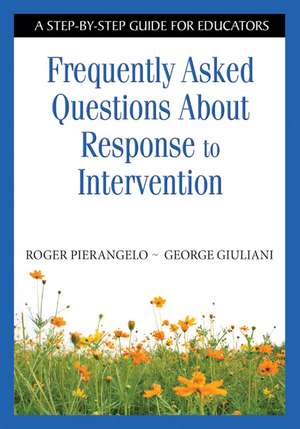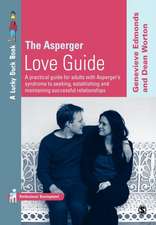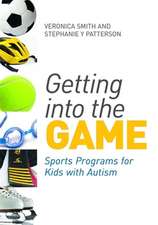Frequently Asked Questions About Response to Intervention: A Step-by-Step Guide for Educators
Autor Roger Pierangelo, George A. Giulianien Limba Engleză Paperback – 11 feb 2008
| Toate formatele și edițiile | Preț | Express |
|---|---|---|
| Paperback (1) | 280.86 lei 6-8 săpt. | |
| SAGE Publications – 11 feb 2008 | 280.86 lei 6-8 săpt. | |
| Hardback (1) | 446.83 lei 6-8 săpt. | |
| SAGE Publications – 25 feb 2008 | 446.83 lei 6-8 săpt. |
Preț: 280.86 lei
Nou
Puncte Express: 421
Preț estimativ în valută:
53.75€ • 55.80$ • 44.82£
53.75€ • 55.80$ • 44.82£
Carte tipărită la comandă
Livrare economică 22 martie-05 aprilie
Preluare comenzi: 021 569.72.76
Specificații
ISBN-13: 9781412917896
ISBN-10: 1412917891
Pagini: 176
Dimensiuni: 178 x 254 x 11 mm
Greutate: 0.37 kg
Ediția:1
Editura: SAGE Publications
Colecția Corwin
Locul publicării:Thousand Oaks, United States
ISBN-10: 1412917891
Pagini: 176
Dimensiuni: 178 x 254 x 11 mm
Greutate: 0.37 kg
Ediția:1
Editura: SAGE Publications
Colecția Corwin
Locul publicării:Thousand Oaks, United States
Recenzii
"Administrators and district staff development personnel will find this book highly useful. The material is clear-cut and reader-friendly."
“The purpose of the book is clear and, it certainly fulfills its purpose. This book is an excellent resource for educators and a great contribution to the field.”
“The purpose of the book is clear and, it certainly fulfills its purpose. This book is an excellent resource for educators and a great contribution to the field.”
Cuprins
Preface
Acknowledgments
About the Authors
1. Making Sense of the Basic Principles of RTI
Question #1: What Is Responsiveness to Intervention (RTI)?
Question #2: What Is the Purpose of RTI?
Question #3: Why Is RTI Important?
Question #4: What Are Other Benefits of RTI?
Question #5: Is RTI a "New Approach"?
Question #6: When Did RTI Become "Law"?
Question #7: Why Was There a Movement for a Change Towards RTI?
Question #8: What Are the Core Principles of RTI?
Question #9: What Is a Tiered Service Delivery Model?
Question #10: What Is the Three-Tier Model?
Question #11 What Is the Focus of Tier I?
Question #12: What Is the Focus of Tier II?
Question #13: What Is the Focus of Tier III?
Question #14: Is RTI Just Applicable to Special Education?
Question #15: What Are Some Conditions and Activities of RTI?
Question #16: Is There Federal Funding to Support RTI-Related Activities?
Question #17: Does RTI Address Challenging Behavior?
Question #18: Does a School District's "Child Find" Obligations Change Within RTI Systems?
Question #19: Is Parent Involvement an Important Component for Successful RTI Programs?
Question #20: Can RTI Promote Optimal Learning?
Question #21: What Is Fidelity?
Question #22: Does Implementation of RTI Methods Require a Serious Commitment?
Question #23: What Does the RTI Process Mean for Teachers?
Question #24: What Do Teachers Need in Terms of Professional Development and RTI?
2. Understand Why RTI Plays an Important Role in the Determination of Specific Learning Disabilities
Question #25: How Does IDEA 2004 Define a Specific Learning Disability?
Question #26: How Have Children Been Identified Under the Category of Specific Learning Disabilities?
Question #27: What Events Led to Changes in LD Identification in IDEA 2004?
Question #28: Why Replace the Discrepancy Model With RTI?
Question #29: What Are Major Issues Related to the Use of the Concept of Achievement-Ability Discrepancy? Why Change?
Question #30: Why Was RTI Considered in the Process of SLD Determination?
Question #31: Today, What Role Should RTI Play in the Identification of Children With a Specific Learning Disability?
Question #32: Can RTI Be Used as the Sole Determinant for SLD Classification?
Question #33: Are There Other Indicators of LD That Are More Valid and Reliable?
Question #34: If Authorities Believe Underlying Processing Disorders Are the Cause of Learning Disabilities, Why Doesn't IDEA 2004 Include a Model Based on Measuring Processing Problems?
Question #35: In the Big Picture, How Does RTI Fit Into the Determination of LD Process?
3. Determine Your School's Capacity to Adopt RTI
Question #36: What Basic Decisions Should a School or District Make Before Implementing RTI?
Question #37: What Approaches Are Available for Implementing RTI?
Question #38: How Do You Measure Academic Growth?
Question #39: How Do You Use Validated Interventions?
Question #40: How Do You Distinguish Between Types of Learning and Performance Problems?
Question #41: How Do You Determine the Effects of Instruction and Make Decisions About Cutoff Criteria?
Question #42: What Are the Different Types of Response to Intervention Models?
Question #43: What Is Problem Solving or Hypothesis Testing?
Question #44: What Are Pre-Referral Approaches?
Question #45: What Is Tiered Intervention?
Question #46: What Resources Are Necessary to Implement an RTI Approach?
4. Screening for "At-Risk" Students
Question #47: What Is Screening?
Question #48: What Considerations Are Part of the Selection of Appropriate Screening Measures?
Question #49: How is Schoolwide Screening Done Within an RTI Model?
5. Determine How Progress Monitoring Will Be Done in an RTI Model
Question #50: What Is Progress Monitoring?
Question #51: How Can Progress Monitoring Be Useful in an RTI Context?
Question #52: What Role Does Progress Monitoring Play in SLD?
Question #53: How Is Progress Monitoring Accomplished in Tier 1?
Question #54: How is Progress Monitoring Accomplished in Tier 2 and Tier 3?
Question #55: How is Progress Monitoring Accomplished in Special Education?
Question #56: Will the Implementation of a Progress Monitoring System Within an RTI Model Require Shifts in School Structures?
6. Understand the Concept of a Multitiered Service-Delivery Model
Question #57: What is a Multitiered Service Delivery Model?
Question #58: Continuum of Intervention Support for At-Risk Students
7. Determine How Problem Solving Will Be Addressed in Making Decisions
Question #59: What is Problem Solving in RTI?
Question #60: Who Is Involved in the Problem Solving Process?
Question #61: In Making Decisions, What Type of Approach Should the Team Follow?
Question #62: What About Using a Standard Treatment Protocol?
8. In the RTI Model Used, Determine How a Tier 1 Intervention Will Be Implemented
Question #63: What Is Tier I-Core Instruction?
Question #64: What Percentage of the Student Body Must Tier I Serve?
Question #65: What Are the Core Features of a Tier 1 Intervention?
Question #66: How Does Tier 1 Fit Within an RTI Model?
Question #67: What is Universal Screening and/or Benchmarking?
Question #68: How is Progress Monitoring Done in Tier I?
Question #69: What if Students Do NOT reach a Proficiency Level at Tier I?
Question #70: How Will Tier 1 Interventions Affect Staff and School Structures?
9. In the RTI Model Used, Determine How a Tier 2 Intervention Will Be Implemented
Question #71: What is an Intervention?
Question #72: What is a Tier 2 Intervention?
Question #73: When Does Tier 2 Intervention Start?
Question #74: What Percentage of Students Need Tier II Interventions?
Question #75: Are Strategic Interventions in Tier II Short or Long-Term?
Question #76: What are the Core Features of a Tier 2 (and beyond) Intervention?
Question #77: How Long Should Tier 2 Interventions Be?
Question #78: What is a Problem-Solving Approach (Individually Designed Instructional Package)?
Question #79: What is a Standard-Protocol Approach?
Question #80: How is Progress Monitoring Done in Tier II?
Question #81: What if Students are Successful at Tier II? What if They are Unsuccessful?
Question #82: How Does Tier 2 (and Beyond) Fit Within an RTI Model?
Question #83: Will Tier 2 (and Beyond) Interventions Affect Staff Roles, Responsibilities and School Structures?
10. In the RTI Model Used, Determine How a Tier 3 Intervention Will be Implemented
Question #84: What are Tier III Interventions?
Question #85: What Percentage of Students Need Tier III Interventions?
Question #86: Are Tier III Interventions Short-Term or Long-Term?
Question #87: Who Delivers Tier III Interventions?
Question #88: Is Progress Monitoring Still a Part of Tier III?
Question #89: How are Tier III Interventions Delivered?
Question #90: What if Students are Successful at Tier III? What if They are Unsuccessful?
11. In the RTI Model Used, Determine When Special Education Should Be Considered
Question #91: Why is Special Education an Integral Step in a Multitiered Model Such as RTI?
Question #92: How Does Special Education Fit Within an RTI Model?
Question #93: When Should a School District Initiate a Special Education Referral in a RTI System?
Question #94: If a Student is Determined Not Eligible for Special Education Services, How Long May That Student Continue to Receive the Intensive Interventions Provided at Tier III?
Question #95: How Might Specially Designed Instruction (SDI) Differ From the Tier III Interventions a Student May Have Been Receiving Prior to Qualifying for Special Education Services?
Question #96: Can a School District use RTI Data to Support the Decision That a Student Has a Disability in a Special Education Disability Category Other Than SLD?
Question #97: How Will Use of the RTI Process Affect Special Education Referrals?
Question #98: What Changes Are Needed in Special Education to Staff Roles, Responsibilities, and School Structures?
12. Determine How Parents/Guardians Will Be Involved in the RTI Model
Question #99: What Does IDEA State About Parental Involvement?
Question #100: What Should Parents Know About the RTI Program in Their School?
Question #101: What Questions Should Parents Ask About RTI in Their Schools?
Question #102: Are There Standards for Judging Parent Involvement?
Question #103: Are There Measures Used to Judge Parent Involvement?
13. Ensure Fidelity of Implementation
Question #104: What Is Fidelity of Implementation?
Question #105: Why Is Fidelity of Implementation Important?
Question #106: How Can Schools Ensure Fidelity of Implementation?
Question #107: What Are the Key Components and Indicators That Lead to Fidelity in General Education?
Question #108: What Are the Three Dimensions That Keep Implementation of Fidelity Manageable for Schools?
Question #109: How Does a School Achieve High Fidelity?
Question #110: Does Fidelity of Implementation Affect School Structures and Staff's Roles and Responsibilities?
14. Review System Requirements for Response to Intervention
Question #111: What Is a Leadership Team?
Question #112: What Is Teaming?
Question #113: How Do You Use a Research-Based Core Curriculum?
Question #114: What Are Valid Screening or Identification Procedures and Decision Rules?
Question #115: What Are Adopted Intervention Protocols and Progress Monitoring Intervention Protocols?
Question #116: What Are Policy and Procedure Development Including Special Education Procedures?
Question #117: What Is Capacity Building?
Conclusion
Glossary
References
Index
Acknowledgments
About the Authors
1. Making Sense of the Basic Principles of RTI
Question #1: What Is Responsiveness to Intervention (RTI)?
Question #2: What Is the Purpose of RTI?
Question #3: Why Is RTI Important?
Question #4: What Are Other Benefits of RTI?
Question #5: Is RTI a "New Approach"?
Question #6: When Did RTI Become "Law"?
Question #7: Why Was There a Movement for a Change Towards RTI?
Question #8: What Are the Core Principles of RTI?
Question #9: What Is a Tiered Service Delivery Model?
Question #10: What Is the Three-Tier Model?
Question #11 What Is the Focus of Tier I?
Question #12: What Is the Focus of Tier II?
Question #13: What Is the Focus of Tier III?
Question #14: Is RTI Just Applicable to Special Education?
Question #15: What Are Some Conditions and Activities of RTI?
Question #16: Is There Federal Funding to Support RTI-Related Activities?
Question #17: Does RTI Address Challenging Behavior?
Question #18: Does a School District's "Child Find" Obligations Change Within RTI Systems?
Question #19: Is Parent Involvement an Important Component for Successful RTI Programs?
Question #20: Can RTI Promote Optimal Learning?
Question #21: What Is Fidelity?
Question #22: Does Implementation of RTI Methods Require a Serious Commitment?
Question #23: What Does the RTI Process Mean for Teachers?
Question #24: What Do Teachers Need in Terms of Professional Development and RTI?
2. Understand Why RTI Plays an Important Role in the Determination of Specific Learning Disabilities
Question #25: How Does IDEA 2004 Define a Specific Learning Disability?
Question #26: How Have Children Been Identified Under the Category of Specific Learning Disabilities?
Question #27: What Events Led to Changes in LD Identification in IDEA 2004?
Question #28: Why Replace the Discrepancy Model With RTI?
Question #29: What Are Major Issues Related to the Use of the Concept of Achievement-Ability Discrepancy? Why Change?
Question #30: Why Was RTI Considered in the Process of SLD Determination?
Question #31: Today, What Role Should RTI Play in the Identification of Children With a Specific Learning Disability?
Question #32: Can RTI Be Used as the Sole Determinant for SLD Classification?
Question #33: Are There Other Indicators of LD That Are More Valid and Reliable?
Question #34: If Authorities Believe Underlying Processing Disorders Are the Cause of Learning Disabilities, Why Doesn't IDEA 2004 Include a Model Based on Measuring Processing Problems?
Question #35: In the Big Picture, How Does RTI Fit Into the Determination of LD Process?
3. Determine Your School's Capacity to Adopt RTI
Question #36: What Basic Decisions Should a School or District Make Before Implementing RTI?
Question #37: What Approaches Are Available for Implementing RTI?
Question #38: How Do You Measure Academic Growth?
Question #39: How Do You Use Validated Interventions?
Question #40: How Do You Distinguish Between Types of Learning and Performance Problems?
Question #41: How Do You Determine the Effects of Instruction and Make Decisions About Cutoff Criteria?
Question #42: What Are the Different Types of Response to Intervention Models?
Question #43: What Is Problem Solving or Hypothesis Testing?
Question #44: What Are Pre-Referral Approaches?
Question #45: What Is Tiered Intervention?
Question #46: What Resources Are Necessary to Implement an RTI Approach?
4. Screening for "At-Risk" Students
Question #47: What Is Screening?
Question #48: What Considerations Are Part of the Selection of Appropriate Screening Measures?
Question #49: How is Schoolwide Screening Done Within an RTI Model?
5. Determine How Progress Monitoring Will Be Done in an RTI Model
Question #50: What Is Progress Monitoring?
Question #51: How Can Progress Monitoring Be Useful in an RTI Context?
Question #52: What Role Does Progress Monitoring Play in SLD?
Question #53: How Is Progress Monitoring Accomplished in Tier 1?
Question #54: How is Progress Monitoring Accomplished in Tier 2 and Tier 3?
Question #55: How is Progress Monitoring Accomplished in Special Education?
Question #56: Will the Implementation of a Progress Monitoring System Within an RTI Model Require Shifts in School Structures?
6. Understand the Concept of a Multitiered Service-Delivery Model
Question #57: What is a Multitiered Service Delivery Model?
Question #58: Continuum of Intervention Support for At-Risk Students
7. Determine How Problem Solving Will Be Addressed in Making Decisions
Question #59: What is Problem Solving in RTI?
Question #60: Who Is Involved in the Problem Solving Process?
Question #61: In Making Decisions, What Type of Approach Should the Team Follow?
Question #62: What About Using a Standard Treatment Protocol?
8. In the RTI Model Used, Determine How a Tier 1 Intervention Will Be Implemented
Question #63: What Is Tier I-Core Instruction?
Question #64: What Percentage of the Student Body Must Tier I Serve?
Question #65: What Are the Core Features of a Tier 1 Intervention?
Question #66: How Does Tier 1 Fit Within an RTI Model?
Question #67: What is Universal Screening and/or Benchmarking?
Question #68: How is Progress Monitoring Done in Tier I?
Question #69: What if Students Do NOT reach a Proficiency Level at Tier I?
Question #70: How Will Tier 1 Interventions Affect Staff and School Structures?
9. In the RTI Model Used, Determine How a Tier 2 Intervention Will Be Implemented
Question #71: What is an Intervention?
Question #72: What is a Tier 2 Intervention?
Question #73: When Does Tier 2 Intervention Start?
Question #74: What Percentage of Students Need Tier II Interventions?
Question #75: Are Strategic Interventions in Tier II Short or Long-Term?
Question #76: What are the Core Features of a Tier 2 (and beyond) Intervention?
Question #77: How Long Should Tier 2 Interventions Be?
Question #78: What is a Problem-Solving Approach (Individually Designed Instructional Package)?
Question #79: What is a Standard-Protocol Approach?
Question #80: How is Progress Monitoring Done in Tier II?
Question #81: What if Students are Successful at Tier II? What if They are Unsuccessful?
Question #82: How Does Tier 2 (and Beyond) Fit Within an RTI Model?
Question #83: Will Tier 2 (and Beyond) Interventions Affect Staff Roles, Responsibilities and School Structures?
10. In the RTI Model Used, Determine How a Tier 3 Intervention Will be Implemented
Question #84: What are Tier III Interventions?
Question #85: What Percentage of Students Need Tier III Interventions?
Question #86: Are Tier III Interventions Short-Term or Long-Term?
Question #87: Who Delivers Tier III Interventions?
Question #88: Is Progress Monitoring Still a Part of Tier III?
Question #89: How are Tier III Interventions Delivered?
Question #90: What if Students are Successful at Tier III? What if They are Unsuccessful?
11. In the RTI Model Used, Determine When Special Education Should Be Considered
Question #91: Why is Special Education an Integral Step in a Multitiered Model Such as RTI?
Question #92: How Does Special Education Fit Within an RTI Model?
Question #93: When Should a School District Initiate a Special Education Referral in a RTI System?
Question #94: If a Student is Determined Not Eligible for Special Education Services, How Long May That Student Continue to Receive the Intensive Interventions Provided at Tier III?
Question #95: How Might Specially Designed Instruction (SDI) Differ From the Tier III Interventions a Student May Have Been Receiving Prior to Qualifying for Special Education Services?
Question #96: Can a School District use RTI Data to Support the Decision That a Student Has a Disability in a Special Education Disability Category Other Than SLD?
Question #97: How Will Use of the RTI Process Affect Special Education Referrals?
Question #98: What Changes Are Needed in Special Education to Staff Roles, Responsibilities, and School Structures?
12. Determine How Parents/Guardians Will Be Involved in the RTI Model
Question #99: What Does IDEA State About Parental Involvement?
Question #100: What Should Parents Know About the RTI Program in Their School?
Question #101: What Questions Should Parents Ask About RTI in Their Schools?
Question #102: Are There Standards for Judging Parent Involvement?
Question #103: Are There Measures Used to Judge Parent Involvement?
13. Ensure Fidelity of Implementation
Question #104: What Is Fidelity of Implementation?
Question #105: Why Is Fidelity of Implementation Important?
Question #106: How Can Schools Ensure Fidelity of Implementation?
Question #107: What Are the Key Components and Indicators That Lead to Fidelity in General Education?
Question #108: What Are the Three Dimensions That Keep Implementation of Fidelity Manageable for Schools?
Question #109: How Does a School Achieve High Fidelity?
Question #110: Does Fidelity of Implementation Affect School Structures and Staff's Roles and Responsibilities?
14. Review System Requirements for Response to Intervention
Question #111: What Is a Leadership Team?
Question #112: What Is Teaming?
Question #113: How Do You Use a Research-Based Core Curriculum?
Question #114: What Are Valid Screening or Identification Procedures and Decision Rules?
Question #115: What Are Adopted Intervention Protocols and Progress Monitoring Intervention Protocols?
Question #116: What Are Policy and Procedure Development Including Special Education Procedures?
Question #117: What Is Capacity Building?
Conclusion
Glossary
References
Index
Notă biografică
Roger Pierangelo is an associate professor in the Department of Special Education and Literacy at Long Island University. He has been an administrator of special education programs and served for eighteen years as a permanent member of Committees on Special Education. He has over thirty years of experience in the public school system as a general education classroom teacher and school psychologist, and is a consultant to numerous private and public schools, PTAs, and SEPTA groups. Pierangelo has also been an evaluator for the New York State Office of Vocational and Rehabilitative Services and a director of a private clinic. He is a New York State licensed clinical psychologist, certified school psychologist, and a Board Certified Diplomate Fellow in Child and Adolescent Psychology and Forensic Psychology. Pierangelo is currently president of The National Association of Special Education Teachers, executive director of The American Academy of Special Education Professionals, and vice-president of The National Association of Parents with Children in Special Education.
Pierangelo earned his BS degree from St. John¿s University, his MS from Queens College, Professional Diploma from Queens College, PhD from Yeshiva University, and Diplomate Fellow in Child and Adolescent Psychology and Forensic Psychology from the International College of Professional Psychology. He is a member of the American Psychological Association, New York State Psychological Association, Nassau County Psychological Association, New York State Union of Teachers, and Phi Delta Kappa.
Pierangelo is the coauthor of numerous books, including The Big Book of Special Education Resources and The Step-by-Step Book Series for Special Educators.
Pierangelo earned his BS degree from St. John¿s University, his MS from Queens College, Professional Diploma from Queens College, PhD from Yeshiva University, and Diplomate Fellow in Child and Adolescent Psychology and Forensic Psychology from the International College of Professional Psychology. He is a member of the American Psychological Association, New York State Psychological Association, Nassau County Psychological Association, New York State Union of Teachers, and Phi Delta Kappa.
Pierangelo is the coauthor of numerous books, including The Big Book of Special Education Resources and The Step-by-Step Book Series for Special Educators.
Descriere
Featuring reader-friendly language, step-by-step guidelines, and informative appendices, this guide introduces educators to the purpose, principles, benefits, and application of this tiered service delivery model.















